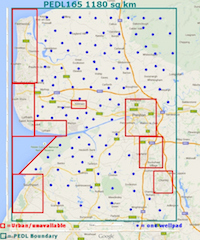Is fracking in PEDL 165 about to be hobbled?
Hot on the heels of the LCC decision to refuse Cuadrilla’s planning applications for Roseacre Wood and Preston New Road we saw a Westminster Hall debate on fracking.
In this debate Kevin Hollinrake, MP for Thirsk and Malton proposed a buffer zone of six miles between fracking sites and an industry scheme that will step up to pay for any damage to the environment and communities, as well as “truly independent monitoring”.
Leaving aside the minor issues of how the damage he mentions can be quantified and who would be paid, and the evident difficulties in finding a truly independent capable monitoring body, this idea of a six mile buffer zone is very interesting isn’t it?
PEDL 165 measures approximately 18 by 24 miles. this means with this restriction Cuadrilla would only be allowed to site about 20 pads in their licence area, even if we ignore the limitations imposed by the various conurbations.
Do Cuadrilla really believe they can operate with just 20 pads? They clearly would like us to think they could make do with 10 or 20 as when challenged to defend their claim that “Some critics have suggested that the area would be blighted by densely packed unattractive developments in the future, if we moved to the production stage. This would not be the case” they responded so that the ASA commented:
..we understood ..there would be approximately one well pad every 23 square miles or 46 square miles depending on whether 10 or 20 well pads were constructed. We understood the well pads would be spread across the 1200-km2 area
However, even with 40 wells per pad this would only give a maximum of around 800 wells. With EUR (estimated ultimate recovery) rates estimated per well by the Institute of Directors at about 3.2 billion cubic feet per well this would only allow for the extraction of about 2.5 trillion cubic feet of gas over the entire project. This is about 10 months worth of annual UK gas demand (which is just over 3 trillion cubic feet a year). Whilst the fracking companies do like to pretend that they may be able to get by with such a low number of sites so that locals don’t get scared in advance, it is hard to see how they can make good on their grand claims regarding their contribution to UK energy needs, or employment or energy security from such a meagre and restricted operational base.
Who on earth then (Cuadrilla included no doubt) would think that continuing on this path makes any sense given the huge expense and local impacts involved?
With the decision at Roseacre making it abundantly clear that the limitations of the rural road network rule out fracking pretty much anywhere not on an A road, it is hard to see where the frackers have left to go from here.

































